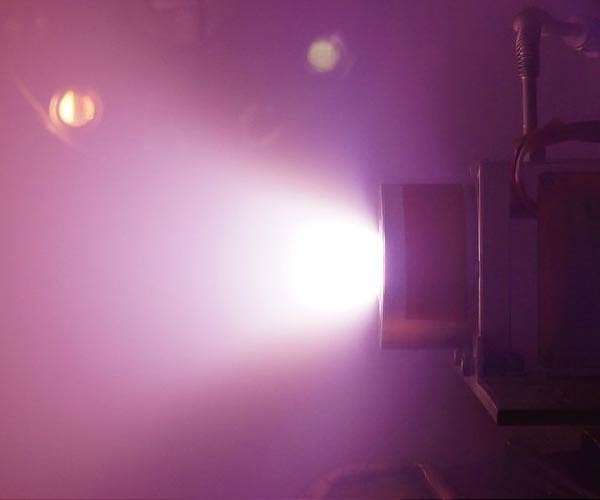
Phase Four achieves electric thruster operation on Air Force Green Propellant ASCENT (Image Credit: Space Daily)
Phase Four, the creator of the radio-frequency thruster (RF thruster) for satellite propulsion, has successfully demonstrated operation of its RF thruster using the Air Force Research Laboratory’s green propellant, ASCENT (formerly AF-M315E). The achievement, made under a U.S. Space Force contract awarded at the 2021 Space Force Pitch Day, enables multi-mode propulsion capability, which combines the high thrust capabilities of liquid chemical propulsion with the high efficiency capabilities of electric propulsion operating on a single common propellant.
“This achievement further underlines the expansive capability of Phase Four’s propulsive technology, which has already been shown to operate on other novel propellants such as iodine and water. We are proud to work alongside AFRL to now demonstrate RF thruster operation on ASCENT and build upon the versatility of this green propellant,” said Jason Wallace, Vice President of Advanced Development at Phase Four.
Jim Bridenstine, former NASA Administrator and recent addition to the Phase Four board of directors, added “With the increasingly congested and contested space domain, ASCENT-based RF thrusters are a critical technology to ensure the United States’ propulsive superiority in space.”
Phase Four tested the RF thruster while flowing ASCENT and the individual gases that make up the green propellant. Throughout the test, Phase Four demonstrated ignition and stable firing over a wide spectrum of thruster operating points, achieving the world’s first cathode-less ASCENT plasma. Future development will focus on fine-tuning plasma performance for ASCENT and other liquid propellants used in monopropellant and bipropellant thrusters, with a focus to provide future space vehicles with the ability to maneuver without regret by delivering operational, turn-key multi-mode propulsion systems.
“Before joining Phase Four, I had the privilege of working with U.S. Space Force senior leaders to build out the concept of multi-mode propulsion and outline the capability it could unlock for national security missions. It became apparent that a game-changing propulsion technology would be required. Only the Phase Four RF thruster provided the necessary architecture to achieve multi-mode capability using novel liquid propellants, such as ASCENT,” said Jesse Sidhu, Phase Four senior systems engineer and technical lead on the program.
“I’m proud to say that the Phase Four team has brought what used to be science fiction into reality. We now look forward to optimizing our thruster and building on this program to deliver unprecedented mission-centric propulsive capability to our warfighters.”
Related Links
Phase Four
Rocket Science News at Space-Travel.Com
|
|
Tweet |
|
|
|
We need your help. The SpaceDaily news network continues to grow but revenues have never been harder to maintain. With the rise of Ad Blockers, and Facebook – our traditional revenue sources via quality network advertising continues to decline. And unlike so many other news sites, we don’t have a paywall – with those annoying usernames and passwords. Our news coverage takes time and effort to publish 365 days a year. If you find our news sites informative and useful then please consider becoming a regular supporter or for now make a one off contribution. |
||
|
SpaceDaily Monthly Supporter $5+ Billed Monthly |
SpaceDaily Contributor $5 Billed Once credit card or paypal |
|
Sidus Space engages Dawn Aerospace to implement propulsion technology into LizzieSat
Cape Canaveral FL (SPX) Nov 02, 2022
Sidus Space, Inc. (NASDAQ:SIDU), a Space-as-a-Service company focused on mission critical hardware manufacturing combined with commercial satellite design, manufacture, launch, and data collection, announced agreement with Dawn Aerospace (“Dawn”) to implement its green, chemical propulsion technology into LizzieSat.
Among the novel characteristics of Sidus Space’s proprietary LizzieSat is that its size allows Sidus to include propulsion and provide precision pointing and maneuvering otherwise not … read more









